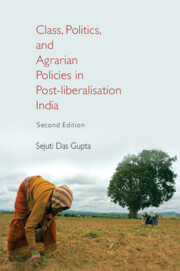Book contents
- Frontmatter
- Dedication
- Contents
- List of Tables and Figures
- List of Abbreviations
- Acknowledgements
- Maps
- 1 Introduction
- 2 Policy-making, Class Factor, and Political Settlement: Setting the Theoretical Framework
- 3 Privatising the Inputs of Production: A Case of Careful Choice of Beneficiaries and Losers
- 4 Chhattisgarh: New State, New Opportunities for Old Class Domination
- 5 Gujarat: Strong State-directed Capitalism across Sectors
- 6 Karnataka: State Patronage, Market Opportunism, and Urban–Rural Closing Gap
- 7 State in Action, Political Settlement, and the Agrarian Flux
- Bibliography
- Index
4 - Chhattisgarh: New State, New Opportunities for Old Class Domination
Published online by Cambridge University Press: 30 April 2024
- Frontmatter
- Dedication
- Contents
- List of Tables and Figures
- List of Abbreviations
- Acknowledgements
- Maps
- 1 Introduction
- 2 Policy-making, Class Factor, and Political Settlement: Setting the Theoretical Framework
- 3 Privatising the Inputs of Production: A Case of Careful Choice of Beneficiaries and Losers
- 4 Chhattisgarh: New State, New Opportunities for Old Class Domination
- 5 Gujarat: Strong State-directed Capitalism across Sectors
- 6 Karnataka: State Patronage, Market Opportunism, and Urban–Rural Closing Gap
- 7 State in Action, Political Settlement, and the Agrarian Flux
- Bibliography
- Index
Summary
Overview
This chapter addresses three primary concerns. First, what kind of political settlement is operating in the newly formed state of Chhattisgarh. Second, what has been the impact of (class) interest on the state apparatus with respect to agricultural policies. Third, in the era of liberalisation, has the market's free play caused a retreat of the state from the sector of agriculture? Additionally, with regard to the consequences of prevailing agricultural policies, if the existing three proprietary classes have transformed themselves, remained unaffected, or have been replaced by new classes since the formation of the state. Land acquisition policy and the political economy around it have been addressed as well. Simultaneously, the implications of these policies on the different fractions of rich farmers and their means of accumulation alongside the other two dominant proprietary classes – industrial capitalist and petty bourgeoisie – have been developed.
Chhattisgarh was created under the Madhya Pradesh Reorganisation Act, 2000. Its creation was more a decision of the national political parties than having been driven by the struggle for regional autonomy under the Chhattisgarh Mukti Morcha (Berthet and Kumar, 2011; Tillin, 2013). The popular story is that the high proportion of tribal (adivasi) population, who had a claim to a separate state, was the basis for the formation of the state. The new state would make things favourable for the tribal population, who would then be able to assert themselves more in the new political entity; this would turn development in their favour. However, arguably, this was not the only reason for the new state formation. The concentration of natural resources fostered the need to make the region into a political entity, so as to facilitate smoother economic access to the resources (Berthet and Kumar, 2011). The state has registered high incidence of food insecurity and low human development. What really has happened since to the political economy unfolds in the following sections.
Geographically, Chhattisgarh is divided into hills in the north and south and plains in the centre. The total population of the state is 26 million (approx.) as per the 2011 census. Scheduled Tribes, who form one-third of the population, inhabit the hills. The Scheduled Castes (11.61 per cent) and other communities, including the Other Backward Classes, form the remaining 55 per cent of the population and live in the central plains.
- Type
- Chapter
- Information
- Publisher: Cambridge University PressPrint publication year: 2024



